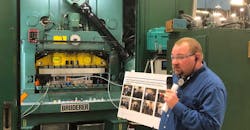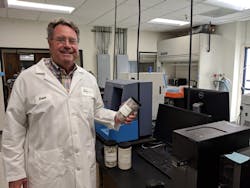Environmental sustainability, as a goal, can sometimes seem either irrelevant or out of reach. But including even small pushes toward sustainability can have a positive effect on a manufacturer's impact—and the bottom line, too. Constructing wind farms and sequestering carbon are great, but so are the smaller, less splashy efforts that manufacturers are adding every day.
Take, for instance, TE Connectivity. The $13 billion company manufactures sensors and connectors that are used in a number of applications: transportation, medical, data communications and the like: in other words, small parts that make a big difference to the finished product. That's not unlike how the company has used its workers to identify small inefficiencies in their plants.
"The Department of Energy brought us the 'treasure hunt' concept," says Carl Schultz, senior director for the company's global EHS program. TE Connectivity is a participant in the Department of Energy's Better Plants program, which brought the idea of treasure hunts to them via their In Plant training workshops. Essentially, a treasure hunt is a collaborative effort: Employees from a cross-section of departments get together in groups and, with the help of "one or two experts and some tools anyone can use," the groups walk the plant floor and find things that need fixing or could use improvement. Previously, Schultz said, TE Connectivity had focused on big energy reduction efforts involving plant infrastructure. Naturally, those also involve a lot of money. The small fixes identified by "treasure hunts," on the other hand, don't.
Changing the air compression system nozzles alone wound up saving the company "hundreds of thousands of dollars." In Schultz's words, "Sustainability is a great thing to do, but we're also a business. We take a hard look at it: what's going to help us, help our customers, etc."
Another benefit of the treasure hunts Schultz identified was their scalability. "We found we could take [treasure hunts] to other plants, without a corporate team," says Schultz, and they have become a regular occurrence at the company. Since they piloted the approach in 2016, Schultz says, they've promoted the practice and now typically run treasure hunts about 50 times a year, sometimes incorporating competitive elements.
The cross-company approach, meanwhile, has helped the initiative impact employee engagement as well: "It gets people engaged. Whether it's in the treasure hunts, the competition, it helps to build that culture of: 'We're doing something that's good for the company, and it's good for the planet. I can feel good about that, as an employee.'"
Rocks for Bucks
Blue Planet, a producer of building materials, has built an entire business model around using an existing sustainable process—carbon capture—to manufacture rocks, specifically limestone aggregate used in place of rocks for construction. Blue Planet manufactures the aggregate by catching the greenhouse gas carbon dioxide from flue gas in industrial plants and mineralizing it. This sequesters the carbon dioxide in a solid form, synthetic limestone, where it can't contribute to climate change.
Brent Constantz, Blue Planet founder and CEO, chose to focus on rocks rather other materials for his carbon mitigation company because "it's one of the largest, most stable markets." According to Blue Planet's website, 70% of the material used in concrete for aggregate is already limestone. That limestone, Constantz says, is expensive, but not because of the raw material: "It's not the cost of mining, sorting and washing it, it's the cost of transporting it."
In short: Rocks are heavy and difficult to transport to where they're needed. Limestone used in concrete in California is often sourced (and transported) from quarries in British Columbia or the Nevada desert. Those shipping and handling costs add up, both in terms of the environmental impact and their financial impact.
Blue Planet is building a factory on the edge of San Francisco Bay, called San Francisco Bay Aggregates. By making their concrete aggregate in the heart of the city, Blue Planet will have a significant pricing edge on mined rock. "It's sort of like these movements where they want to grow vegetables locally," says Constantz, "except rocks weigh a lot more than cabbages."
From Faulty to Friendly
You don't have to be making rock out of thin air to make your supply chain more sustainable, though. Ginger Butz, director of product lifecycle management at Morey Corp., brought up a commonplace best practice that incidentally makes Morey Corp.'s electronics manufacturing business more environmentally friendly: using data analytics software to determine how many parts per million are faulty.
"Basically, they're calculating how many failures you have per million units that you build," she says. "What that equates to is then if we're building a quality product, our customers aren't scrapping them, and scrapped things end up in landfills."
All of these manufacturers consider their sustainability efforts worthwhile. Most consider sustainability important in itself, but all had a good case for various other benefits, like improving worker morale, removing wasteful processes and reducing shipping costs. The biggest obstacles mentioned were predictable: capital and scale.
"It's not an obstacle per se, but we, like everybody, have limited capital," says Schultz. "People say, 'oh, we can put in solar power, that'll be great.' It'll pay for itself, but it'll take 10 or 20 years to recover the investment."
Blue Planet, meanwhile, is attempting to grow enough to serve all the businesses who've approached them and asked about how to make their own concrete projects greener.
"We're talking to Facebook and other people, because they want to have carbon neutral projects, but our focus right now is on San Francisco International [Airport]," says Constantz, where Blue Planet contributed concrete used for Interim Boarding Area B.
There are big opportunities in sustainability, but a lot of the more revolutionary decisions are expensive, in terms of company resources as well as money. As Schultz puts it for his "treasure hunts," though, implementing small, lean best practices can reap significant rewards.
About the Author
Ryan Secard
Associate Editor
Ryan Secard joined Endeavor B2B in 2020 as a news editor for IndustryWeek. He currently contributes to IW, American Machinist, Foundry Management & Technology, and Plant Services on breaking manufacturing news, new products, plant openings and closures, and labor issues in manufacturing.


